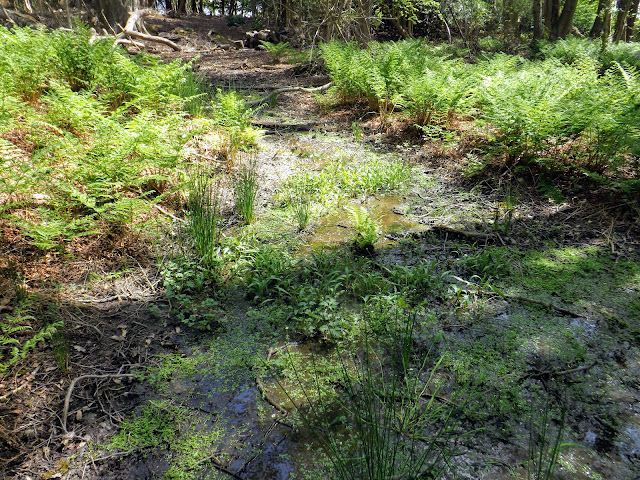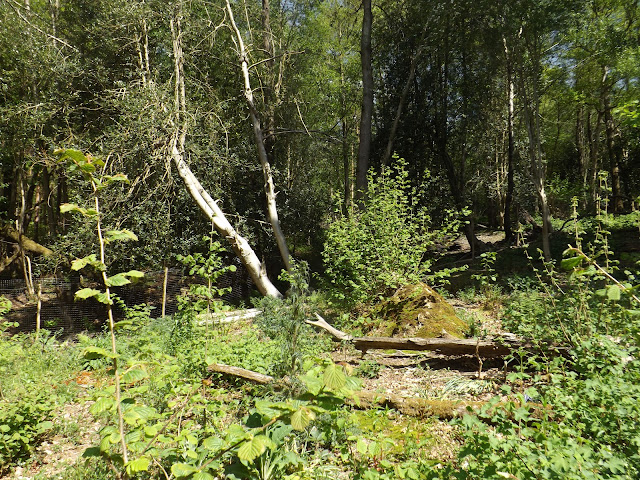I started writing this in the middle of a short July heatwave. Luckily it's fairly easy to keep cool in the wood. We spent a weekend at the cabin which was gorgeous but still chilly enough at night to get the blankets out. We caught up with the bats we hadn't seen for a while and sat by the Pond at dusk watching them swoop and flutter out of the trees and skim across the water, almost brushing against my head, which felt a bit too close for comfort.
This silver washed fritillary took a fancy to a colour matched Sainsbury's bag on the sunny cabin deck. They live in oak or mixed woodland and feed on nectar from thistles and brambles. Well we've got plenty of those.

Here's a few 2022 Spring Bluebell Glade pictures, The bluebells get better each year, spreading like wildfire throughout the wood. Oh, better not use the W word. So far this year, despite the dryness no wildfires have started (especially by the irresponsible person who managed to start one a couple of years ago by lighting a fire directly on tinder dry ground).


 |
|
The most notable difference in the wood between last year and this year is the gathering pace of natural regeneration, most notably in the areas where the bracken battle has just about been won. The main species springing up all over, being oak, beech, birch, rowan, alder buckthorn, and heather, with masses of ground cover , much of which we haven't even identified. A variety of grasses have sprung up on the Rides, and the restored Hazel Coppice is quite choked with new flowering plants including wild daffodils. Much of it must be protected from the deer with tree tubes and temporary deer fencing , but the young birch is doing a great job of protecting it too. Fallow deer are welcome to eat as much of it as they want.and we'll remove a lot of it when it's done the job of helping successful regeneration. We might enlist some birch clearing help from children who always enjoy a bit of light felling. Most of the explosion of growth is welcome, but some of it isn't , especially Tutsan (St. John's Wort) which has in places , become rampant, unwelcome, and difficult to eradicate.
Our restored hazel coppice has been surprisingly successful, with the young hazels managing to outpace the now abundant ground cover plants, even the 7ft tall foxgloves. Pleased with its success, we extended it further earlier this month and protected the new area with temporary deer netting. It's made a real difference to a part of Old Copse that borders the road.
The hazel coppice enclosure protected by fencing so the deer can't eat new growth. Right now we're thigh deep with wild red currant and wood spurge.
The Willow Grove is doing well and looks lush and beautiful. We hope the Purple Emperor butterflies and marsh tits have been enjoying it. We planted lots of willow cuttings after the pollarding last winter. Most of them have taken, but the deer have chomped a few. Time to put a protective tube over them.We plan to gradually extend the willow grove area to join up with the wet wood. Natural England suggest that instead of pollarding (cut above deer munching height), we could coppice (cut them to the ground) We don't know what the benefits of doing this would be, and of course, deer would be in like a shot to eat the regrowth so we would have to protect it with deer fencing. We will probably stick to pollarding.
One of the sprouting willow plants as yet not chewed by deer.
Recently we had a couple of interesting meetings with Sussex Wildlife Trust and Natural England (who came to check on the SSSI site at Old Copse which runs the entire length of the pond, and up to the main Ride . Among other suggestions, they said that we might need to be thinking of a second Scots Pine thin. The original thin of around 30% was done in late 2015. Well, we are thinking about this - albeit cautiously - due to the explosion of bracken and bramble that we soon learned will follow on from letting in more light. While bramble has its uses and isn't too much of a problem, bracken removal is an ongoing job every Summer. We don't want to use chemicals so there's no alternative to tackling it by hand from mid-April to early September in carefully selected areas when it starts to make its annual appearance and before it gets too tall and completely out of hand. It works! The horrible stuff eventually throws in the towel and species regeneration starts to happen. That's such a great reward. We are trying to keep to 'Continuous Cover' principles, which helps to keep light levels manageable, but still, we know that we're going to have to bite the bullet and take more Scots Pine down sooner or later.......
Another suggestion by both Natural England and Sussex Wildlife was to clear a large section of birch monoculture and replant for diversity. Gulp! more bracken and bramble to look forward to if we do this, so we're planning a more cautious approach with some more gradual 'halo' thinning (felling only around existing non - birch, broadleaf trees) . At the Southern part of Old Copse there is birch and Scots pine and hardly anything else ( except the Wet Wood, Hazel Coppice , and Willow Grove, but there is a lot more tree diversity among the birch at the Northern end of Old Copse. Why this should be, we don't know.
A suggestion by Sussex Wildlife Trust we viewed with more enthusiasm than for tree thinning, was to extend the 'wet wood' area by using damming techniques to slow the draining of rain and natural Spring water into the Pond. This would create a larger wet area, and be excellent for wildlife. This sounds interesting and we hope to carry out this improvement at some point during Autumn/Winter, 2022/23
 F Wet Wood floor, still pretty wet, even in a hot dry Summer.
F Wet Wood floor, still pretty wet, even in a hot dry Summer.
This is the first year since 2009 that large sections of Old Copse are looking very 'jungly', and really beginning to look and feel much more like a 'proper' broadleaf ancient woodland, rather than a Scots Pine plantation on an ancient woodland site. Without a photographic record it would be very difficult to remember just how uncared for it was in 2009, when nothing had been done for many years, and it was full of crowded, fallen over Scots Pine, and spindly birch . Keeping this blog reminds us of progress made towards a restored woodland with a diversity of mixed age and mixed species, and of course the work taken to help it on its way. Some of the changes are subtle and of course there's still a great deal more to do, in order to return the whole 30 acres to a 'Healthy' condition. According to Natural England the SSSI section of the wood is now listed as 'Recovering' which is a great acknowledgement of the effect of our work so far, What we've learned over the years is that the complete restoration of 30 acres is a long game. The photos we take are invaluable for our records, as it's hard to register the extent of the day to day changes. I hope they give at least some idea of how wonderful Old Copse looks in the height of summer, as in every season.

Broom and birch are regenerating as more light reaches the woodland floor. Young heather hides small oak seedlings and alder buckthorn.
On-going bracken clearance has improved diversity allowing a wide variety of grasses to come up which were previously out-competed by the bracken.

A veteran beech - one of our two largest trees - lost its top in Storm Arwen earlier in the year, but. it's still alive and the extra light will doubtless bring more growth to the woodland floor.
The cabin looks as if it's becoming buried in heather, willow, rowan and regenerating birch which have sprung up between the pines.
....and........ rest, though sadly there's never a lot of time to lie in the shade of a beautiful oak when there's work to be done.

















